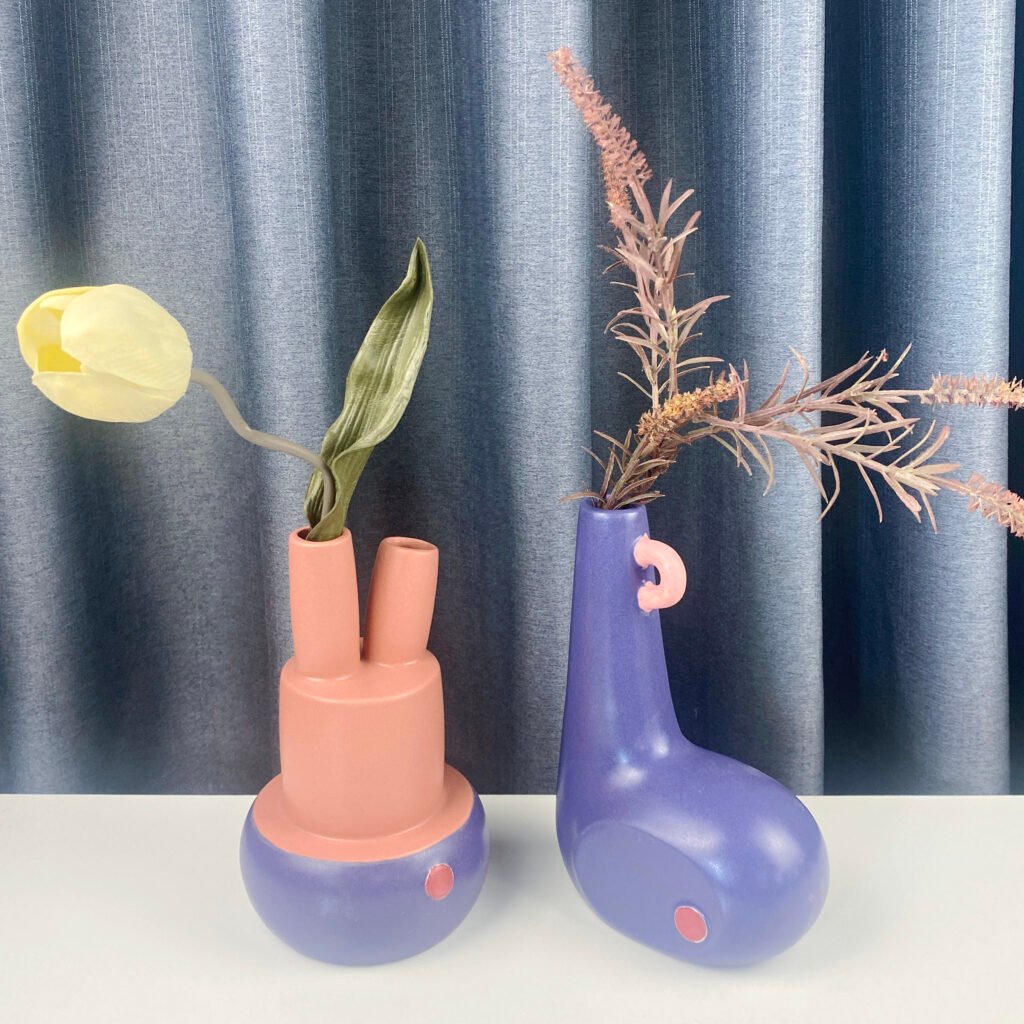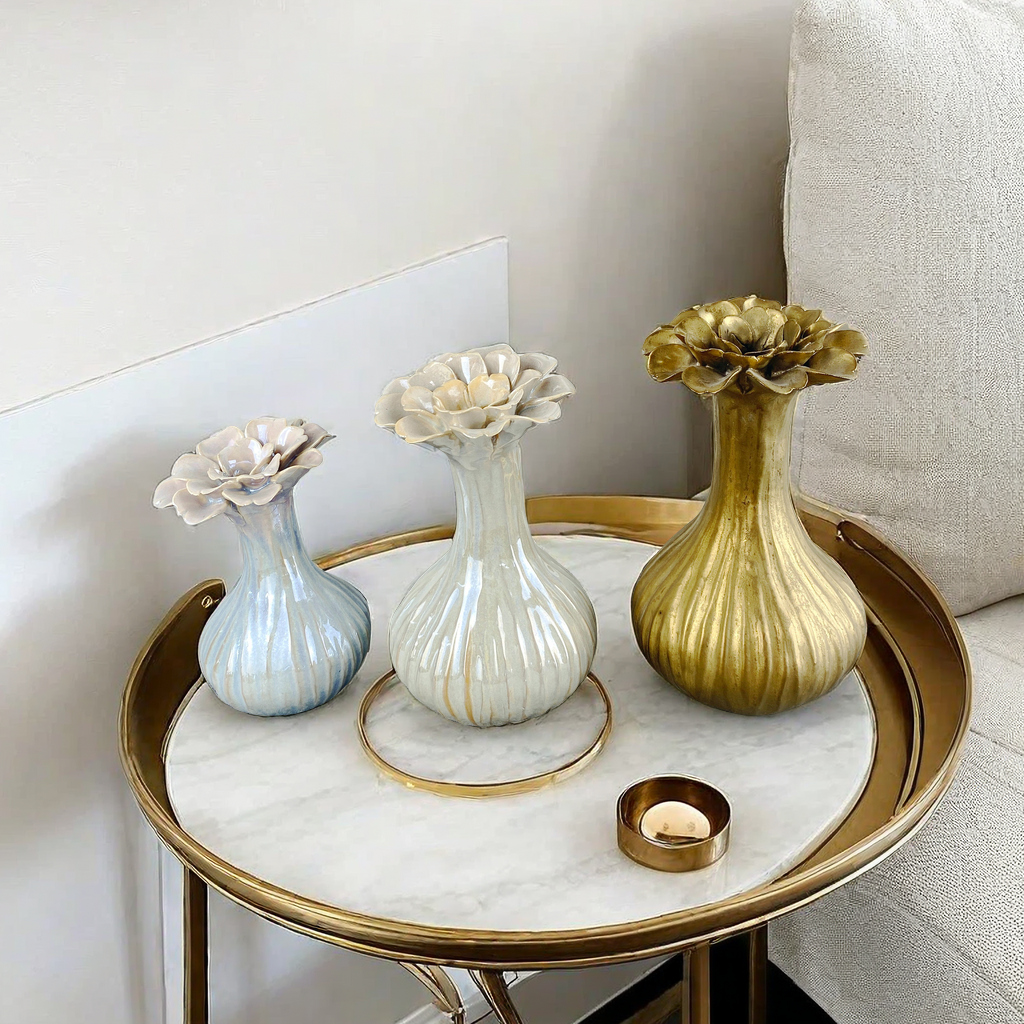In the realm of decorative and functional home goods, vases are essential items that add character and elegance to any space. Among the various types of vases available in the market, ceramic and porcelain stand out as the two most popular materials. For B2B purchasers, understanding the differences between these two materials is crucial for making informed buying decisions. This article will delve into the nuances of ceramic and porcelain vases, examining their composition, production processes, pricing, market suitability, and more.
1. Understanding the Materials-ceramic vs porcelain
1.1 Composition
Ceramic Vases
Ceramic is a broad term that encompasses a range of materials made from clay, which is fired at high temperatures. Ceramic vases can be classified into various types, including:
- Earthenware: Made from red or brown clay, fired at low temperatures, earthenware is porous and typically less durable. It often has a rustic appearance and is less expensive.

- Stoneware: Fired at higher temperatures, stoneware is denser and less porous than earthenware, making it more suitable for functional items. It often has a more refined finish and can be glazed in various colors.

Porcelain Vases
Porcelain is a specific type of ceramic made from a refined clay known as kaolin, mixed with other materials like feldspar and quartz. The mixture is fired at significantly higher temperatures (between 1200°C to 1400°C), resulting in a denser, stronger, and more translucent material than standard ceramics. Porcelain vases are known for their elegant appearance and high durability.

1.2 Physical Properties
- Ceramic Vases: Generally, ceramic vases can vary widely in terms of density and strength, depending on their type. They may be either glazed or unglazed, influencing their aesthetic and functional properties. While they can be durable, they are more prone to chipping and cracking compared to porcelain.
- Porcelain Vases: Porcelain is recognized for its exceptional durability and non-porous nature, which prevents liquid absorption. It typically boasts a smooth, glossy finish, adding to its visual appeal. The translucency of porcelain allows for intricate designs and colors that are less achievable in ceramic vases.
2. Production Processes-ceramic vs porcelain
2.1 Firing Temperature
The firing process is pivotal in determining the characteristics of the final product.
- Ceramics: Typically fired at lower temperatures (around 800°C to 1200°C), ceramic vases may lack the strength of porcelain. This lower firing temperature allows for faster production but can result in a more fragile product.
- Porcelain: The high firing temperatures used in porcelain production contribute to its strength and durability. This process also leads to its refined finish, making it suitable for high-end applications.
2.2 Glazing and Finishing
- Ceramic Vases: Glazing can significantly alter the appearance and functionality of ceramic vases. Glazed ceramics can feature a wide range of colors and patterns, appealing to various consumer preferences. The thickness of the glaze may also vary, impacting durability.
- Porcelain Vases: Porcelain vases are usually glazed to enhance their shine and protect the surface, but the glaze is often thinner than that of ceramic vases, allowing the material’s translucency to shine through. This characteristic is particularly valued in decorative applications.
3. Pricing Considerations-ceramic vs porcelain
3.1 Production Costs
- Ceramic Vases: Generally, ceramics are less expensive to produce due to the availability of raw materials and the lower costs associated with firing. This makes ceramic vases a popular choice for businesses looking to offer affordable options to their customers.
- Porcelain Vases: The production of porcelain is more costly due to the quality of materials used and the high-temperature firing process. As a result, porcelain vases typically carry a higher retail price, positioning them as premium products in the market.
3.2 Market Pricing
- Ceramic Vases: The price range for ceramic vases is broad, catering to various budgets. These vases are suitable for mass production, making them an attractive option for retailers targeting a wide audience.
- Porcelain Vases: Porcelain vases are generally marketed at higher price points, appealing to consumers seeking luxury and quality. Retailers that offer porcelain products can position themselves in upscale markets, benefiting from the material’s inherent prestige.
4. Market Suitability-ceramic vs porcelain
4.1 Target Audience
- Ceramic Vases: These vases appeal to a diverse range of consumers, including budget-conscious shoppers and casual decorators. Their versatility and affordability make them suitable for mass-market retailers, garden centers, and home goods stores.
- Porcelain Vases: Best suited for high-end clients or specialty markets, porcelain vases are often found in luxury home decor shops, gift stores, and boutique retailers. Their elegance and durability attract consumers looking for premium decorative items.
4.2 Seasonal Trends
Both ceramic and porcelain vases can benefit from seasonal trends, but their appeal may vary based on consumer preferences.
- Ceramic Vases: Often utilized in seasonal decorations, ceramic vases can be produced quickly to meet changing market demands. Their affordability makes them ideal for festive occasions and themed decor.
- Porcelain Vases: More likely to be marketed during special events, such as weddings or anniversaries, porcelain vases are often associated with elegance and sophistication. Limited edition pieces can create a sense of exclusivity, driving consumer interest.

5. Pros and Cons of Each Material-ceramic vs porcelain
5.1 Ceramic Vases
Pros:
- Affordable pricing
- Wide variety of styles and colors
- Suitable for mass production
Cons:
- More prone to chipping and cracking
- Porous nature may limit functionality in certain contexts
5.2 Porcelain Vases
Pros:
- High durability and strength
- Elegant appearance with translucency
- Non-porous, making them suitable for a range of uses
Cons:
- Higher production and retail costs
- Limited availability of unique designs compared to ceramics
6. Conclusion
For B2B purchasers, the choice between ceramic and porcelain vases hinges on understanding the unique attributes of each material. Ceramic vases offer affordability and versatility, making them ideal for mass-market appeal. In contrast, porcelain vases provide durability and elegance, suited for high-end markets.
As businesses look to expand their product offerings, aligning with consumer preferences and market trends will be key to success. By carefully evaluating target audiences, production capabilities, and pricing strategies, retailers can effectively navigate the complexities of the vase market and optimize their procurement decisions.
Recommendations for Procurement
- Assess Your Target Market: Understand your customer demographic to determine whether they lean towards budget-friendly or premium products.
- Evaluate Production Capabilities: Ensure that suppliers can meet your demands for either ceramic or porcelain vases, considering factors such as lead times and quality control.
- Monitor Market Trends: Stay informed about seasonal trends and consumer preferences to adjust your inventory and marketing strategies accordingly.
- Consider Design Variety: Ensure a diverse range of designs and styles in your inventory to appeal to different customer tastes and preferences.
- Focus on Quality: Prioritize high-quality products that meet or exceed customer expectations, as this will foster loyalty and encourage repeat business.
By understanding the fundamental differences between ceramic and porcelain vases, businesses can make strategic procurement choices that enhance their product offerings and ultimately drive success in the competitive home decor market.

